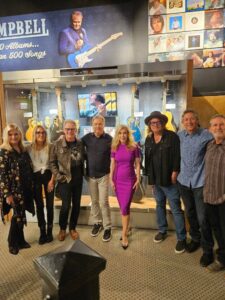In honor of Black History Month, the Musicians Hall of Fame and Museum would like to honor and highlight a handful of the countless significant and influential accomplishments of African Americans in the world of popular music. From the revolutionary Fisk Jubilee Singers, to the creation of the Four on the Floor Disco beat by Philadelphia Sigma Sound musician, Earl Young, the Musicians Hall of Fame and Museum pays homage to these important moments in both Black history and Music history through educational exhibits celebrating the fantastic musicians who created them.
The Musicians Hall of Fame and Museum’s Motown exhibit is a re-creation of Motown’s first recording studio and headquarters located in Detroit, Michigan, “Hitsville U.S.A,” this exhibit highlights not only the larger than life stars to emerge from Motown, but the studio musicians who aided in creating a number of the most recognizable and celebrated songs of all time. Motown was home to a group of legendary studio musicians known as “the Funk Brothers.” Considered to be one of the most successful groupings of studio musicians in music history, the Funk Brothers played on numerous Motown hits such as “My Girl,” “I Heard it Through the Grapevine,” “Baby Love,” “Signed, Sealed, Delivered I’m Yours,” “Papa Was a Rolling Stone,” “The Tears of a Clown,” “Ain’t No Mountain High Enough,” and “Heat Wave.” The Motown exhibit at the Musicians Hall of Fame and Museum includes James Jamerson’s 1961 Fender Precision bass, Eddie Willis’ Gibson 355 guitar, Uriel Jones’ Gretsch drum kit, and more.
Similarly to the Motown exhibit, the Stax Records exhibit at the Musicians Hall of Fame and Museum aims to educated visitors on the history of Stax Records through the stories and success of the studio musicians who recorded there. The exhibit is a re-creation of the Stax Records store front in Memphis, Tennessee, a location that was a movie theater converted into a recording studio. Originally named Satellite Records, Stax Records focused on R&B/southern soul music backed by their legendary house band, Booker T. & the M.G.’s. Among the many successful artists to record at Stax were Otis Redding, Sam & Dave, Isaac Hayes, Eddie Floyd, and Rufus Thomas. The Musicians Hall of Fame and Museum’s Stax Records exhibit displays a number of iconic instruments played on Stax recordings, including Andrew Love’s King Tenor Saxophone and Al Jackson Jr.’s Ludwig Drum Set.
Unlike the Motown and Stax Records exhibits at the Musicians Hall of Fame and Museum, the Sun Studio exhibit focuses less on studio musicians and more heavily upon the vast, diverse, and skilled artists who recorded there. Though best known for its Rockabilly, Country, and Rock and Roll artists such as Elvis Presley, Carl Perkins, and Charlie Rich, Sun Studio, otherwise known as Sun Records or Memphis Recording Service, also recorded many African American R&B and Delta Blues musicians. Little Milton, B.B. King, Junior Parker, Rosco Gordon, James Cotton, Rufus Thomas, and Howlin’ Wolf all recorded at Sun. It is at this location where many believe the first rock and roll single was ever recorded, “Rocket 88” by Jackie Brenston and his Delta Cats. Among the several significant Sun Studio artifacts that the Musicians Hall of Fame and Museum has on display is a visual and informational wall dedicated to Sun’s R&B years, as well as an Apex tape recorder that was used to record artists like B.B. King, Howlin’ Wolf, Ike Turner, James Cotton, and Little Milton.
Among the recording studio exhibits at the Musicians Hall of Fame and Museum are displays which showcase the accomplishments of individual artists as well. The B.B. King exhibit is an example. This exhibit includes one of King’s Epiphone “Lucille” guitars gifted from King to his granddaughter before being acquired by the Musicians Hall of Fame and Museum, a 1969 Gibson 335 walnut finish guitar that was owned and played by King, acquired by the museum in 2015, and the custom tuxedo jacket worn by King during his performance at the White House on February 21, 2012.
Perhaps one of the most unique exhibits at the Musicians Hall of Fame and Museum is the Jimi Hendrix Exhibit. A completely immersive experience unlike any other, the Jimi Hendrix exhibit chronicles Hendrix’s life from joining the United States Army to headlining the Woodstock festival, with special attention given to his formative time living and playing in the Nashville music scene. The exhibit includes a number of Hendrix’s personal clothing items, Mitch Mitchell’s 1967 silver sparkle Ludwig drum set that can be heard on “All Along the Watchtower” and “Crosstown Traffic,” a 1967 Fender Sunburst Stratocaster owned and used by Jimi Hendrix for songwriting and recording, and the actual stage Hendrix performed on from the Jolly Roger club that was once located in downtown Nashville in Printers Alley.
Through exhibits such as those dedicated to Motown, Stax Records, Sun Studio, B.B. King, and Jimi Hendrix, the Musicians Hall of Fame and Museum aims to promote the education of significant music history moments while also providing credit and praise to the deserving musicians and visionaries who created them. With Black History Month being an important and noteworthy time of year, the Musicians Hall of Fame and Museum is honored to celebrate and highlight a handful of the countless accomplishments achieved by African American musicians.





One Response
My brother Aaron Dodd was a black musician who played the tuba. He played with Earth Wind and Fire before they became famous. I have his tuba .
What would you suggest I do with his tuba to keep his legacy alive.
Tuba